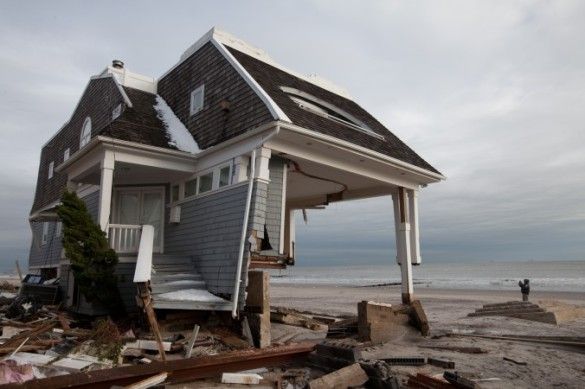Report Makes Case Against Rebuilding The Coastline After Sandy

In the aftermath of Superstorm Sandy, a common theme circulating in the social and political atmosphere has been one of defiance. The message has been to rebuild and redevelop, even in the most vulnerable coastal communities. A report in Mother Jones is arguing that the attitude of continually trying to defy nature is costly, risky and could very well backfire despite billions in planned improvements.
In their analysis, Mother Jones target comments made by prominent political leaders and suggest that “retreating” from the coastline might be a more a realistic option:
Retreat needs to be considered not as a defeatist last-resort, but as proactive strategy needed in some places.
Take New York City, for example, where Mayor Michael Bloomberg has proposed 257 initiatives to be pursued over the next 10 years at an estimated $20 billion. He has repeatedly emphasized that the city “will not retreat from the waterfront.” But it will be hard to stand by this categorical commitment as sea levels continue to rise.
Meanwhile, New York Governor Andrew Cuomo proposed a $400 million home-buyout program, of which a meager $170 million has been HUD-approved. Only homes with damage more than 50 percent of their value are eligible. The Oak Beach community in Staten Island has applied as a pilot program for a community-based buyout, but hasn’t yet been approved. New Jersey Governor Chris Christie is encouraging rapid rebuilding while also proposing a limited buyout program. But with no funding set aside for it, he has made clear he prefers to rebuild rather than retreat.
The report lays out the case that rising flood insurance premiums coupled with expensive new building regulations laid out by FEMA create unfavorable options for homeowners trying to live in coastal communities. Previously, we had reported on the new flood lines drawn by FEMA that will drastically increase costs for homeowners in vulnerable areas. For example, if you have a $250,000 home with a ground floor four feet below sea level, and cannot meet FEMA’s new building regulations, you may have to pay $9,500 a year in flood insurance. By comparison, a home hoisted three feet above the flood line will only have to pay $427 a year, but the cost of doing so will be expensive.
It is because of these reasons that the Mother Jones report is advocating other options like buyouts, curtailing development and fixing the infrastructure:
These options should include support for buyouts in mid-Atlantic communities, at least for coastal and estuary locations that are either at elevations of ten feet or less above the local mean higher high tide or 5 feet above the latest mapped FEMA 1 percent per year base flood elevations, whichever is higher. Once buyouts at these elevations are secured, they should progress to higher elevations.
Disallow new residential development in those low-lying elevations unless it is flood-adapted (safely moored and floatable or substantially raised with raised or floodable utility connections). With urgency, local building codes need to be re-written to take this into account, since those specifications don’t yet exist.
Know that flood-protective structures—sea gates, levees, or walls—have limits. To start, sea levels will inevitably surpass their finite design heights. But before that ever happens, they introduce their own collateral hazards. A barrier system meant to protect an estuary or river with considerable discharge could flood communities behind the protective systems.
Develop a set of land-use priorities. Infrastructure, including transportation networks, sewage treatment plants, solid waste facilities, energy supply and distribution systems, utilities, and public health facilities demand the highest priorities for adaptation, whether by protection, accommodation (some utility distribution systems could be made submergible; other system elements could be raised or made floatable); or by retreat to higher ground. In any case, for this essential infrastructure, higher flood standards need to be considered (such as the 0.2%/year flood elevations), and margins for sea level rise must be added that are in a time horizon commensurate with the expected lifetime of the facility itself. New rights of way will need to be relocated from low-lying areas to higher elevations.
The report even goes as far to suggest creating alternatives to subway systems, which they believe are too vulnerable to constant predicted future flooding, calling for an overhaul of the century old rail system.
Interesting stuff. Whether or not you accept the recommendations in this report, the critical point is that the city is at a crossroads with billions of federal dollars to spend on potential solutions. It is up to our political leaders, engineers and city planners to make sure that they are covering every angle of the recovery process and make decisions that mitigate the full impact of future natural disasters.




